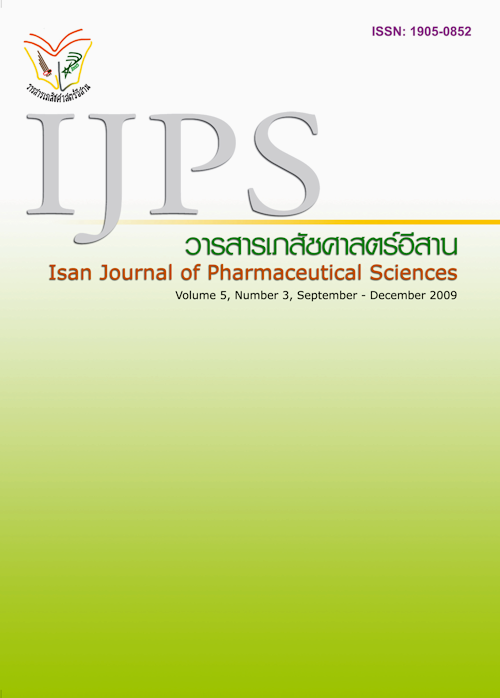Antioxidant Activity and Cytotoxicity in Breast Cancer Cells Line of Mushrooms Extracts; Lentinus polychrous Lev. Compared to Ganoderma lucidum (Fr.) Karst
Main Article Content
Abstract
This study examined the antioxidative activity, and cytotoxic effect in breast cancer cell line (MCF-7) of medicinal mushrooms extracts; Lentinus polychrous Lev. and Ganoderma lucidum (Fr.) Karst. Antioxidative activity and cytotoxic effect were determined using the 1,1-diphenyl-2-picrylhydrazyl radicals (DPPH) assay and the Neutral red assay, respectively. Results show that G. lucidum extracts from mycelia have antioxidative activity with the DPPH scavenging capacity in the range 1.34±0.12 and 13.77±0.98 µmol/g and the total phenolic compounds in the range 9.91±2.32 to 119.70±1.74 mg/100g. L. polychrous Lev. extracts from mycelia had antioxidative activity with the DPPH scavenging capacity in the range 1.33±1.58 to 11.84±1.77 µmol/g and the total phenolic compounds was approximately 10.42±0.69 to 116.57±5.27 mg/100g. This study shows that an extract from edible L. polychrous Lev. mushroom extracts exhibited similar antioxidative activity and the total phenolic compounds to the G. lucidum extracts. Moreover, the extract from G. lucidum caused a 50% decrease in breast cancer cell viability with concentration (IC₅₀) of 415.6 µg/mL. The extract from L. polychrous Lev. mycelia demonstrated IC₅₀ values greater than 500 µg/mL. It was found that the L. polychrous Lev. Mycelia extract; an edible mushroom in Thailand, possessed radical scavenging activity and the total phenolic content were not different from the G. lucidum extract. Future work on the separation of bioactive compounds contributing to the antioxidant activity and cytotoxicity of the L. polychrous Lev. Mycelia extract should be performed in comparison to the G. lucidum extract.
Article Details
In the case that some parts are used by others The author must Confirm that obtaining permission to use some of the original authors. And must attach evidence That the permission has been included
References
Acharya K, Yonzone P, Rai M, Rupa A. Antioxidant and nitric oxide synthase activation properties of Ganoderma applanatum. Indian J Exp Bio l2005; 43(10): 926-931.
Ajith TA, Janardhanan KK. Indian medicinal mushrooms as a source of antioxidant and antitumor agents. J Clin Biochem Nutr 2007;40(3): 157-162.
Alma ERE, Hyun JL, Robert BB, Mariadel MJG, Daniel JR. Enhancement of the antioxidants ergothioneine and selenium in Pleurotus eryngiivar. eryngii basidiomata through culturalpractices. World J Microbiol Biotechnol 2009;25: 1597-1607.
Arora D. Mushrooms Demystified. BerKeley: Ten Seed Press; 1986.
Barros L, Calhelha RC, Vaz JA, Ferreira ICFR, Baptista P, Estevinho LM. Antimicrobial activity and bioactive compounds of Portuguese wildedible mushrooms methanolic extracts. Eur Food Res Technol 2007; 225: 151-156.
Bondet V, Brand-Williams W, Berset C. Kinetics and mechanism of antioxidant activity using the DPPH free radical method. Lebensm -Wissu-Technol 1997; 30(6): 609-615.
Charida P, Poonpilai S, Emiko S, Hisashi H, Yoshinori N. Combination of laccase, xylanase and cellulose In lignocellulose degradation bywhite rot fungi, Lentinus polychrous Lev. and L. squarrosulus Mont. Kasetsart J Nat Sci2004; 38(1): 65-73.
Chang ZQ, Hwang MH, Rhee MH, et al. The invitroanti-platelet, antioxidant and cellular immunity activity of Phellinus gilvus fractionalextracts. World J Microbiol Biotechnol 2008;24: 181-187.
Naomi K, Keiko I, Tojiro T, Koji Y, Masuka K. Inductionof apoptosis in cancer cells by bilberry (Vaccinium myrtillus) and the anthocyanins. J Agric Food Chem 2003; 51: 68-75.
Liu F, Ooi VEC, Chang ST. Free radical scarvenging activities of mushroom polysaccharide activities. Life Science 1997; 60(10):763-771.
Lin ZB. Focus on anti-oxidative and free radicalscavening activity of Ganoderma lucidum. J Appl Pharmacol 2004; 12: 133-137.
Mau JL, Tsai SY, Tseng YH, Huang SJ. Antioxidant properties of methanolic extracts From Ganoderma tsugae. Food Chemistry 2005;93(4): 641-649.
Piljac J, Martinez S, Valek L, Ganic KK. A comparison of methods used to define the phenoliccontent and antioxidant activity of Croatianwines. Food Technol Biotechnol 2005; 43:271-276.
Tong CC, Choong YK, Umar NAB, Noordin MM, Mohamed S. Cytotoxicactivity induced by crudeextracts of Ganoderma lucidum (W.Curt.:Fr.)P. Karst. on mouse myeloma cancercell-line. World J Microbiol Biotechnol 2009; 25:687-695.
Tsenga YH, Yangb JH, Mau JL. Antioxidant properties of polysaccharides from Ganoderma tsugae. Food Chemistry. 2008; 107(2):732-738.
Sun J, He H, xie BJ. Novel antioxidant peptides from fermented mushroom Ganoderma lucidum. J Agric Food Chem. 2004; 52(21): 6646-6652.
Yana S, Jing H, Wei K, et al. Identification of Inonotus obliquus and analysis of antioxidation and antitumor activities of polysaccharides. Curr Microbiol 2008; 57: 454-462.
Yang Hl. Ganoderic acid produced from submergedculture of Ganoderma lucidum induces cell cyclearrest and cytotoxicity in human hepatoma cellline BEL7402. Biotechnology Letters 2005;27: 835-838.
Ying JZ, Mao XL, Ma QM, Zong YC, Wen HA. Icons of medicinal fungi from China. Beijing: Scientific Press; 1987.
Zhao L, Zhao G, Du M, Zhao Z, Xiao L, Hu X. Effect of selenium on increasing free radical scavenging activities of polysaccharide extracts from a Se-enriched mushroom species of the genus Ganoderma. Eur Food Res Technol2008; 226: 499-505.

